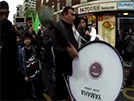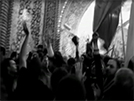Introduction
- Details
- Hits: 15706
Introduction
--------------------------------------------------------------------------------
Allah, the Most High, has said:
} إِنَّ أَوَّلَ بَيْتٍ وُضِعَ لِلنَّاسِ لَلَّذِي بِبَكَّـــــةَ مُّـبَارَكاً وَّ هُدىً لِّلْعَالَمِينَ {
“Surely the first House which was appointed for mankind (as a place of worship) was that in Bakkah (Makkah), the blessed, and a source of guidance for the entire universe.” (Surat Aale ‘Imran (3), Verse 96)Humanity is continuously being overwhelmed by the problems of day to day life in the quest for both their true and perceived material needs; they are plagued with bureaucracy, their own daily professions, and keeping abreast with the news of things happening around themin their own country and throughout the world. All of these things prevent a person from enacting his divinely granted responsibilities and the lofty goals which he sets for himself.
Such a busy life keeps one negligent of one’s original identity and true (eventual) abode. It is the Hajj which acts as a sacred migration from all of the things which one is tied down with in one’s daily life and also the habits which one becomes accustomed to. Thus, through Hajj, an individual evolves into a person who begins to travel back towards Allah and towards his Allah-given innate character and being.
By performing the Hajj, a person is able to be present in the general yearly gathering of Muslims from the entire world, and one can witness the Divine, along with others who believe in the same religion, have one aspiration and are all worshipping the Only Creator.
Being present in the Miqat (spot of wearing the Ihram), chanting the Talbiyyah (Labbayk Allahumma Labbayk…), performing the tawaaf around the House of Allah, performing Salat, running between the mountains of al-Safa and al-Marwah, trimming the nails or hair, then making the great move to ‘Arafat, then Mash’ar, followed by Mina, and culminating this great act of worship with the sacrifice of an animal, and then finally shaving the head – all of these acts have thousands of secrets and mysteries related to them which are obviously not possible to explain in the light of forty short Ahadith (as will be covered in this booklet).
However, it is important to note that a portion of the secrets behind all of these acts of worship, which are both political and spiritual, is that they actually pull a person towards a greater study and research of the Islamic texts and are actually the cause for the thirst towards more knowledge and a stimulation to learn more about the faith.
The minute intellectual reflections and small goals which people have for themselves, take on a much larger scale when they are engrossed in the great universal gathering of Muslims. Without a doubt, it is within such a venue that an individual wishes and desires the hopes and aspirations not only for himself, rather for all Muslims. The Hujjaj participating in this great Abrahamic journey, spiritually link their actions with those done by the great prophets of the past and open up the doors of the historical past to their own realm of understanding.
The Divinely taught sacred call of “Labbayk Allahumma Labbayk…” brings to mind the ancient pledge, pact, and innate covenant which mankind made with their Creator aforetime. It is through putting on the white clothing of the Ihram that a person removes the spiritually dark traits of selfishness, pretentiousness, and the rampant desire to fulfill one’s sensual pleasures, and puts an end (hopefully not temporarily) to one’s evil habits and actions. Through this clothing which one has now donned, one sees and understands that all the praise, blessings, and power belong solely to Allah (SWT).
The etiquette related to being inside the Sanctuary (Haram) teaches us the noble ethical traits and the sacred Divine morals which we must enact at all times in our lives. In the physical actions of the Hajj, we are taught the lessons of unity, the importance of keeping the spiritual realm and politics together, maintaining true faith, building alliances with other Muslims, and the true meaning of freedom. At the same time, we are also taught to stand up and fight against disbelief, polytheism, and other Satanic forces as one firm unit of Muslims. It is through the tawaaf in the presence of one’s Beloved and standing at the Maqam of Ibrahim and performing the Salat that a person becomes one with the Angels in the heavens who are performing the same action!
Through the act of the Sa’i between the mountains of al-Safa and al-Marwah and then trimming the hair, a person is finally permitted to once again circle the Ka’bah in the final tawaaf, known as the Tawaaf an-Nisa, where he finishes off this entire Hajj by standing at the Maqam-e-Ibrahim and performing one final two Rak’at Salat.
It is through greeting the Hajrul Aswad and even kissing it that a person renews the pledge one made in the other world, as the Qur’an mentions:
}ÙˆÙŽØ¥Ùذْ أَخَذَ رَبّÙÙƒÙŽ Ù…Ùنْ بَنÙÙŠ آدَمَ Ù…Ùنْ ظÙÙ‡ÙورÙÙ‡Ùمْ Ø°ÙرّÙيَّـتَهÙمْ وَأَشْهَدَهÙمْ عَلَى أَنْÙÙسÙÙ‡Ùمْ أَلَسْت٠بÙرَبّÙÙƒÙمْ قَالÙوا بَلَى Ø´ÙŽÙ‡Ùدْنَا أَنْ تَقÙولÙوا يَوْمَ الْقÙيَامَة٠إÙنَّا ÙƒÙــنَّا عَنْ هٌذَا غَاÙÙÙ„Ùينَ {
“And when your Lord brought forth from the children of Adam, from their backs, their descendants, and made them bear witness against their own souls: ‘Am I not your Lord?’ They said: ‘Yes! we bear witness.’ Lest you should say on the Day of Resurrection: Surely we were heedless of this.” (7:172)
It is only through drinking the delicious water of the well of Zamzam that a person is able to once again hear the whisper of life flowing through one’s entire body and soul…
The momentary stops through the Hajj and the movements made from one place to another by the command of Allah (SWT) and with the remembrance of Allah (SWT) teach a person the Abrahamic way of life. It is through the acts of the slaughtering of an animal that a person is able to slit the throat of his negative trait of miserliness, and it is through the act of shaving the head that one begins to prepare himself once again to be able to enter into Masjidul Haraam, the house of his Beloved.
However before this, one must make his way to the Jamarat to stone the large, medium and small representations of the Satan. Through this act, he announces his disavowal and disapproval from anything Satanic and anything which has polytheistic undertones to it.
That which we have mentioned in this short booklet is a collection of forty ÙAhadith in regards to this great obligatory act – the Hajj.
These Ahadith go forth to elucidate and explain some of the etiquettes and goals behind the Hajj. The sacredness and sanctity of the sites of Hajj and the role which they have in the life of a person have also been alluded to in our selection of narrations. The short traditions, which we have quoted in this work, come to us from the Infallible Leaders of the faith (AS), and open up a new outlook to the beautiful visage of the Hajj. The visitors to the sacred house of Allah, or those who have a strong desire to make the trip, but have not yet been blessed to do so, would do well to study these carefully.
Øجكم مقبول Ùˆ سعيكم مشكور
‘May your Hajj be accepted and may all of your efforts be appreciated.’
Mahmud Mahdipur











